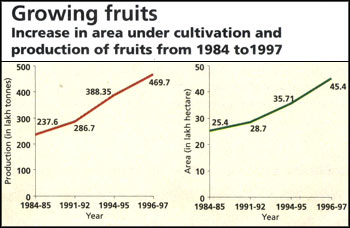Fabled Fruits!
 Dwindling diversity
Dwindling diversity
India holds the distinction of being the world's second largest producer of fruits, both major and minor. But many of the fruits native to India are being less and less savoured
Fruits come in all shapes and sizes. Neatly stacked in wooden crates and placed under bright lights, the fruit markets attract buyers from each and every stratum of society. Vendors call out to advertise their wares, mouth-watering delicacies exchange hands for printed pieces of paper as quick deals are struck between haggling housewives and clever sellers. But behind the garish lights is concealed a harsh reality. Even as the market place seems to be teeming with fruits, the genetic biodiversity of fruits in India is being rapidly eroded.
Fed up eating just bananas, mangoes or grapes, you decide to check out if the fruits you relished in your childhood are still available. But there is nothing the market has to offer other than the more common varieties. You ask for khirni, and the reply is, "Does anyone buy khirni nowadays?" The answer is no different for other lesser-known fruits. By the end of the gruelling session through the market, you're left wondering where all the fruits you grew up with have gone.
India has much to offer in terms of fruit diversity. The country can boast of as many as 50 indigenous fruits. And if you take their wild relatives and allied species into account, the number of native varieties goes up to a whopping 400. Found in diverse climatic conditions (see map: Fruits of India), some of the native fruits are mango, banana, citrus, jackfruit, aonla (Embilica officinalis), jamun (Syzygium species), ber (Zizyphus species), bael (Aegel marmelos), chironjii (Buchanania lanzan), ker (Capparis decidua), karonda (Carissa carandas).... The list is endless. Of these, varieties of major fruits like mango, banana and citrus are grown in abundance in many parts of the country. There are also some commercial varieties - pineapple (Ananas comosus) and papaya (Caria papaya), for instance - which are not native to the country but are cultivated over large tracts of land.
Minor tropical fruits which are basically collected from the wild and eaten by the local inhabitants include her, bael, jamun, karonda, aonla, fig (Ficus carica), phalsa (Grewia subinaequalis) and kokam (Garcenia indica). Besides, there are the "under-utilised" fruits like the tamarind which exhibit rich diversity, but are not commercially important. Their cultivation is restricted to small farms, backyards or marginal land which is not suited for commercial fruits. The choice of species also depends on the multipurpose use of the plant.
Fruit diversity is found in abundance mostly in the jungles or untapped regions. However, consumption is restricted to the growing areas due to various factors. For instance, the passion fruit which is in great demand in Mizoram is not seen anywhere else because of the poor communication link the state has with the rest of the country. Some of the fruits found in the wild are yet to be sampled adequately, leave alone marketed. But with no incentive available to the growers to cultivate these lesser-known fruits, several varieties are on the verge of extinction.
Though the area under fruit cultivation and fruit production have gone up over the years, it is at the cost of a number of native fruits. Just a few are being produced, with preference being given to commercially viable ones, not necessarily native. And even in the fruits that are being produced, the varieties are limited (see graph: Growing fruits).
Some reasons for loss the of biodiversity:
• Deforestation and habitat destruction is leading to genetic erosion of fruits. An assessment of 32 indigenous fruits show "medium" to "high" erosion in all fruits. These fruits that were assessed include banana, mango, citrus and aonla,
• Collection and conservation of genetic diversity is not a national priority. Though fruits comprise 25 per cent of agricultural exports, only 7.7 per cent of the agricultural budget is allocated to horticulture.
• Even the germplasm that has been collected has not been documented, evaluated or characterised.
• Efforts at exploring diversity within fruits is still at a primary stage.
• S Lack of a ready market for most fruits is leading to cultivators shifting to more commercially viable fruit varieties, which are not necessarily native.
Unless we have a fruit policy, what you find in the market today may not be there when you decide to go fruit shopping next.
